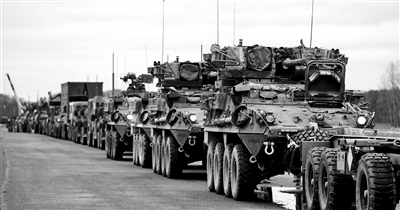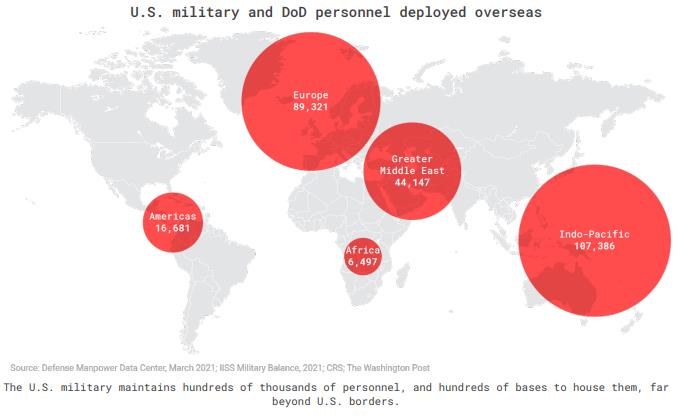
By Chen Hanghui, Guan Ying
Day earlier, the US Department of Defense announced two reinforcements to Europe in response to the tension on Russia-Ukraine border. Once deployed, the total number of American troops in Europe will exceed 90,000, the largest in the past decade.
In recent years, the US has kept expanding overseas troops and making redeployments around the world to maintain its global hegemony, which have caused regional tension and turmoil and been strongly criticized by relevant countries.
Sending more troops to Europe against adversary and allies alike
Unlike the Trump administration that arm-twisted its European allies to share the defense responsibilities, the Biden administration, as soon as it came in office, announced lifting the upper limit of 25,000 active U.S. troops in Germany. Statistics show that as of September 2021, there were about 88,000 American service members in Europe, roughly 34% of America’s global deployments.
As America is moving its strategic focus eastward to the Indo-Pacific, Biden administration's continued reinforcement of troops in Europe revealed deep strategic considerations. Holding fast to its position as the world's only superpower is America's core interests, and underpinning that is its control over Europe. Meanwhile, as it always views Russia as the most pressing realistic threat, hyping up the Russian threat to Ukraine can fuel up the tension between Russia and European countries, make Europe more dependent on America's security protection, and therefore justify its reinforcements to the continent. Therefore, sending more troops to Europe is against both the adversary and the allies.
Making deployments in Indo-Pacific to consolidate presence and exercise deterrence
In the security domain, the Biden administration has inherited the so-called “major-country competition” strategy from its predecessor and gone to great lengths to increase troops, adjust the power deployment and build military facilities in this priority region.
America is intensifying forefront deterrence along the first island chain. When Biden came in power, he reaffirmed the defense commitment to ROK and sent more troops to the country; he increased the number of destroyers in the 7th Fleet to eleven and enhanced the reconnaissance and monitoring capabilities and missile matrix construction on Japan’s southwest islands, in the attempt to build a net of precise fire strikes against China along Japanese islands.
America is accelerating battlefield construction in Pacific island states between the second and third island chain. In recent years, the US military has developed a string of new combat concepts such as Distributed Lethality and Agile Combat Employment, the gist of which is using the myriad of islands between the second and third island chain to carry out distributed operations and “island hopping” and increase the American soldiers' battlefield viability in the Indo-Pacific region. In the next few years, the US military will continue to strengthen the security cooperation with Pacific island states and turn them into a pivot and rally and preparation zone against the West Pacific.
America is fortifying its soft military presence in the Indo Pacific. In addition to deploying troops and weapons, the country is also helping hone the combat capabilities of its regional allies and partners by selling them weapons and equipment and carrying out joint exercises and training.
It’s worth mentioning that the Interim National Security Strategic Guidance released by the Biden administration proposed to scale back on the number of troops stationed in the Middle East. It's possible that the US military will readjust the geographical distribution of its large military bases overseas and move some resources to the Indo Pacific.
Making crossover integration in pursuit of competitive advantages
Statistics show that the number of American troops overseas increased by 30% from 200,000 to 260,000 between 2017 and 2021. Yet the more eye-catching part is Pentagon's integrated deployment of its global combat forces.
In September 2012, the US Joint Chiefs of Staff put forth the idea of “global integrated operations (GIO)”, asking US troops around the globe, backed by advanced information and network technology, to quickly realize capability integration and efficient coordination with each other and with partners across domains, levels, theaters and agencies.
In August 2021, the US military carried out the Large Scale Exercise 2021, in which it mobilized 25,000 American sailors and marines from the US homeland, Africa, Europe and the Pacific. A senior military officer said the exercise simulated global integrated operations and more would come up in the future.
America's obsession with the power of force and insistence on sending more troops overseas despite its overall decline is neither good for itself nor conducive to world peace and stability. It will only find itself the target of more criticism and objection if it continues to cling to the Cold War mindset and stir up regional turmoil out of selfish purposes.














